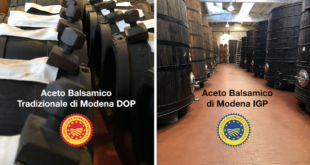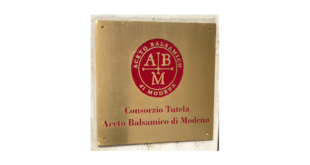Balsamic vinegar of Modena IGP is a far more recent product than traditional one. Here in this article we provided you with the “behind the scene” of it.
Production
Is a product born for market, the productive technique is far more recent that the traditional, the product comes from the mixing of wine vinegar and cooked must, the disciplinary of production provides that the vinegar is left to mature and refine for at least 60 days before the bottling and more than 3 years the one denominated “aged”.
Practically, B.V.M. (Balsamic vinegar of Modena IGP) doesn’t undergo through those fermentation phenomenons, enzymatic processes and neither to the oxygen exchange, typical of Traditional balsamic vinegar, that causes the continuous concentration.
For several of these products, setting just few months in the barrels, the concentration is given, concentration is only given by the density of cooked must, wisely calibrated with wine vinegar.
In 2009 the European Community recognised it the I.G.P. (indication of geographical origin); since then the productive system is granted by the production regulation and monitored by the certifying authority designated by the Ministry for Agriculture and by the local health service.
The locals for production are the acetifici, factories where any kind of equipment for the control of temperature and humidity is allowed, in order to have a major control and to have a constant production.
Raw material
In 2009 the European community recognised the status of I.G.P. to the grapes used for production.
B.V.M. must be produced within the province of Modena and come from the following wineyards: Lambrusco (all the varieties), Ancellotta, Trebbiano (all the varieties), Sauvignon, Sgavetta, Berzemino, Occhio di Gatta.
The fresh musts destined to the production must undergo through a process of refrigeration, this will allow the decantation of the heaviest particles and conservation of the flower must before the cooking. Refrigeration cannot bring to the freezing of the watery part.
Production regulation provides that the cooking happens in opened jars on a direct flame for at least 30 minutes to a temperature no less than 80°, a good cooking takes place for 12 hours.
Every other type of must is strictly forbidden, even the ones produced through enology, because they are prepared with different techniques, for example: the concentrated, the rectificated, the mute musts, the annealed musts and the one with additives in it.
Fermentation
Production of Balsamic Vinegar of Modena IGP is made by mixing different products, cooked must and vine vinegar, of which just one went through fermentation: vine vinegar.
Barrels
Recently, virtually all the producers of B.V.M.switched to wood barrels, due to a need related to the commercialization.
But, when the container is too big there are no advantages respect to the iron ones, because the product doesn’t get any influence by the scent of the wood.
Noteworthy, many producers use 40000 liters containers, so the dimension doesn’t touch the quality of product.
It is thought that the maximum dimension that allows an influence from the wood is 20 hectolitres.
Organoleptic parameters
To an organoleptic analysis the scents in the B.V.M. are brought by the cooked must and the vine vinegar: must gives sweetness and vinegar gives the tart.
Factors determining the price:
Quantity of used must – Quality of vine vinegar – Dimension of the container
Caramel presence
Caramel is necessary because it colours and gives density to the product and it also covers some smells contained into low-quality vine vinegars.
Qualityand quantity of used must
Is the most important entry in the balsamic vinegar based products, because is the one that gives flavour and scent.
The cost for the raw material varies from about 3,50/4,50€ for the D.O.C. (Denomination of controlled origin) musts, to 0,50/1,00€ for the concentrated ones coming from South America.
Usually, our musts are less concentrated because they come from indigenous grapes from Modena that need to ferment.
The quantity goes from a 10% minimum to a 100% (in cases must exceeds the percentage of 25% it must necessarily undergo a process of fermentation)
Quality of vine vinegar
Normally, vinegars with acidity that goes from 7,5 to 10,5 acetic degrees, according to the product that must be obtained.
Price varies from 0,5 to 1,00 € per liter.
In case of scarce quality products it will confer the final product with its smell and taste.
The absence of balsamic scents and tastes make the Balsamic vinega of Modena IGP a total different product compared with Traditional Balsamic Vinegar of Modena DOP.
Bottles
Production regulation allows the producer to decide which bottle to use, but there’s the obligation to be more than 250 ml. – you can also use containers from 500 ml., 750 ml., 1 l., 2 l. 5 l.
But, a consortium bottles exists that is available to all the producer that want to use it, in order to identify easily the product.
Usually, producers prefer using their own bottle because is connected to their enterprise image.
Recognition
In 2009 the European Community granted the Balsamic Vinegar of Modena IGP status (Indication of geographical protection)
 Use Balsamic Vinegar All you need to know about Balsamic Vinegar of Modena
Use Balsamic Vinegar All you need to know about Balsamic Vinegar of Modena


